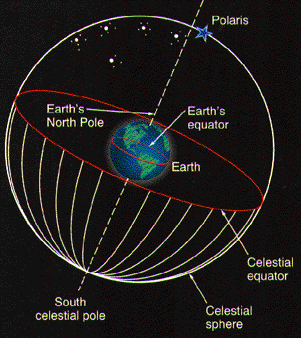

Astronomy 110 Homework #1
Due September 11th, 2012
Name:_________________________________
The celestial equator is the projection of the Earth's equator onto the celestial sphere (see page 28). It divides the sky in to two regions: northern and southern hemispheres. The angular distance from the celestial equator to the north celestial pole (to Polaris, the pole star) is 90o. This set-up is shown in the drawing below (ignore the fact that they drew Polaris slightly off to the side!).


1) Can someone in the southern hemisphere (south of the equator) see Polaris? (4pts)
2) What is the elevation angle of Polaris if you a) lived on the equator, b) lived at the north pole, and c) lived at a latitude of 45o north (6pts).
The zenith is the point in the sky straight overhead, that is the point in the sky that always has an elevation angle of 90o. The angle between the zenith and the celestial equator is exactly equal to your latitude. So the elevation (or altitude) of the celestial equator on the meridian is simply 90o - Latitude.
3) We live in Las Cruces, with a latitude of 32.5o. What
is the altitude/elevation angle of the celestial
equator at the meridian? (5pts)
4) If an object is located 10 degrees south of the celestial
equator, what is its altitude angle as
it crosses our (Las Cruces) meridian? (5pts)
5) Las Cruces has a Longitude of 106.5 degrees. Give that the
Earth rotates 360 degrees in 24 hours, one hour is 15 degrees.
How many "hours" are we (West) of longitude 0 degrees (i.e., London)? How did
the affect the coverage of the 2012 Olympics? (5pts)